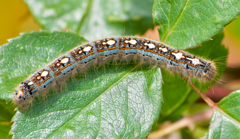Common Name
Forest Tent Caterpillar
Latin Name
Malacosoma disstria
Order
Lepidoptera
Family
Lasiocampidae
Main Host(s): Sugar Maple (Acer saccharum), Red Oak (Quercus rubra), Trembling Aspen (Populus tremuloides), White Ash (Fraxinus americanus), White Birch (Betula papyrifera), fruit trees and others.
Life Cycle
All Tent Caterpillars are native insects having a similar life cycle and they are the most widely distributed insect species in North America. They have one significant difference: the Forest Tent caterpillars make a type of silken mat on the tree branches or on the trunk of host trees while the Eastern and the Western Tent caterpillars (Malacosoma americanum, Malacosoma californicum) build tent-like webs.

The Western and the Eastern Tent caterpillars affect various fruit trees and shrubs while the Forest Tent caterpillar affects deciduous trees such as Aspen, Maple, Oaks and Poplars. The life cycle and the damage cause by the forest Tent caterpillar is described below.
The Forest Tent caterpillar has a one-year life cycle. After overwintering as a fully developed embryo within the eggshell, the larvae hatch in the spring when the leaves expand and feed them. As they grow, larvae stay together in colonies and start building a silken mat on the branch and trunk of host trees. They rest and molt in these mats. A month and a half after hatching, they start building their cocoons and change to pupae. The moths come out about 10 days after and live only for a few days. The eggs are laid in masses of 200 to 250 around twigs and mature in less than a month. They do not hatch before the next spring.
Impact & Damage
Tent caterpillars are primarily a nuisance. Infestations generally last no more than three consecutive years but can cause severe defoliation. When abundant, the caterpillars can eat all the leaves on the trees. Most of the time trees recover, but it does reduce growth and make the trees more susceptible to other hazards. Defoliated trees will normally produce new leaves during the season.
Resources
Learn more about Tent Caterpillar
Quick Links
Contact a Valent BioSciences public health representative.
Contact Us